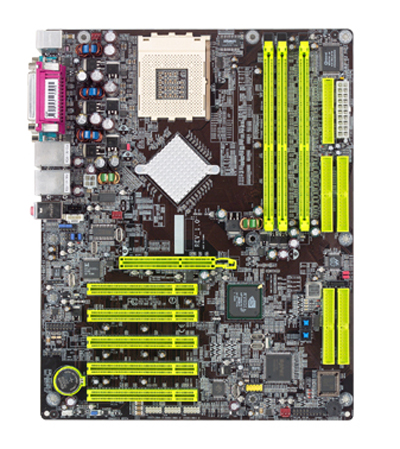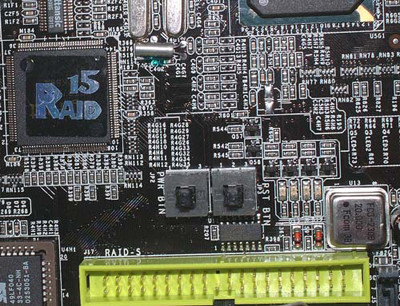DFI NFII Ultra: Mean Green Dream Machine
by Wesley Fink on July 30, 2003 6:25 PM EST- Posted in
- Motherboards
DFI NFII Ultra LanParty: Board Layout
The DFI NFII Ultra, like other LanParty boards, has an excellent layout. We have yet to see the perfect motherboard, however, so we do have a few minor annoyances to report.
More and more top-end AMD motherboards are implementing both the standard ATX 20-pin connector and the 4-pin 12-volt connector that are part of the Pentium 4 Power Supply specification. DFI has provided both connectors on the NFII. The location of the 20-pin is virtually ideal – to the right of the DIMM slots at the top corner. This is a great location for most case designs - even full towers. Although the 4-pin 12V connector is in a common location to the left of the CPU socket we prefer the 12V to the right of the CPU socket between the CPU and DIMM slots, and as close to the top of the board as possible. The DFI worked fine with the single ATX connection, but we ran all benchmarks with both the ATX and secondary 12V connector. The DFI was built for overclocking, and the 12V connector will likely increase board stability in extreme overclocking situations.

It is easy to argue both sides of DFI’s decision to use a huge passive heatsink for the nForce2 Ultra 400 Northbridge. Some will prefer the passive heatsink, while others would prefer active cooling. The proof, in the end, is how effective the solution works. We had no problems whatsoever, even overclocking as high as 228 FSB, with overheating of the heatsink. Please also take note of the cute little heatsink that DFI has applied to the power transistor, below left of the heatsink. This has been a component that often gets hot on other nForce2 boards, and we are happy to see DFI add cooling to this component. It seems to work well and stay reasonably cool.
One concern with a large passive heatsink, particularly those mounted diagonally like the nFoece2 boards, is whether large heatsinks will fit. The Thermalright SK-7, which uses a clip for connection, fit with no problem at all – even with an 80mm fan attached. However, there are no mounting holes around the CPU socket, which will be important to some. Several water-cooling blocks and a few very large heatsinks require the four mounting holes for proper setup. The mounting holes are not part of the current AMD specification, but boards targeting the enthusiast market would do well to include the mounting holes to avoid customer disappointment.
The Floppy connector and Primary/Secondary IDE connectors are in the ideal position - closer to the top of the board and to the right of the DIMM slots. This will allow IDE cables to reach the upper bays of almost any case design. Depending on your case design, you will either love or hate the IDE RAID connector locations. If you have a case with drive bays to the right of the motherboard, the location at the bottom right of the board will seem ideal. If your hard drives must mount in the upper bays of a tower case, you will probably wonder what DFI was thinking in their design. For the majority of case designs, the lower right location for hard-drive-only connections makes more sense.

Abit received a lot of positive comments when they began putting momentary power and reset switches on their top-line overclocking boards. Everyone raved about this nice touch for the serious computer hobbyist. Well, good ideas tend to get adopted by others, and DFI has included push-button Power and Reset switches on the NFII Ultra. In fact, DFI is using the switches as part of their signature design for the LanParty boards. The onboard switches are just another touch to let the end-user know that this is a board designed for serious computer users.










46 Comments
View All Comments
Anonymous User - Sunday, August 10, 2003 - link
why is everyone going nuts over this,this is aNforce2 ultra400 chipset so its new the asus a7n8x deluxe its a Nforce2 chipset so its old why compare an old MB with a old chipset with the new chipset,i own both boards and the DFI its 12% faster than asus and its the best
overcloking board for the athlon that i have used.
OH and xtras lots of Xtras for the price, with this board i was able to clock my 2500+ to 2466 MHZ no problem with the asus and same proc i only reach that # and it would not boot at all
and if U where wondering i got version 2.0 of the asus. peace
Anonymous User - Tuesday, August 5, 2003 - link
#34, did you read the review or any of the comments from the editors? You'd have to be stupid to think that DFI's nForce2 Ultra 400 motherboard would show anything different from the many nForce2 and KT600 motherboards AT has reviewed here. Look at any of the past few motherboard reviews and you'll clearly see nForce2 is faster than KT600, and that all nForce2 boards are no faster than each other, varying in performance by no more than 1%.Jeez, why should AT even bother posting reviews for such clueless readers with an ignorant attitude.
Anonymous User - Sunday, August 3, 2003 - link
It does not matter how new he is to Anandtech, there must be an editor responsible enough to make the call as to whether or not this review was worth putting up. In my opinion, I see little or no value to this review because there is no comparison worth mentioning. Come on! A Ti4600 on 3 motherboards but the review board has a 9800!When I finally got the the benchamrks and realized what was being done, I was through taking this article seriously. What is to be gained by reading this? You must compare it to a comparable system with the same components.
What gives with the two different hard drives listed in the setup? Was the DFI using the faster drive while the others used the slower setup?
Cashmoney995 - Sunday, August 3, 2003 - link
Its free, and Anand would never accept any type of bribe from the companies. Its not the easiest thing running a FREE to view website, and doing a multitude of benchmarks on THEIR free time. Just chill a bit guys, we dont want to become completely cynical. AT says the DFI mobo is the best deal out there, and I think im gonna pick one up. I bought a Chaintech and have had horrible experiance with the drivers especially for audio, it comes out all scratchy and the provided driver doesnt even work! Even worse is the horrible chaintech website which does shit for letting u contact support.Anonymous User - Saturday, August 2, 2003 - link
Posting an email i sent here but didn't get any response to regarding this article:"Please correct me if I am wrong but from what I understand Soundstorm is a
certification given to a motherboard that guarantees it meets certain
specification set by Nvidia/Dolby guys. I also understand that it's a money
issue a lot of manufacturer don't pay to be certified, the sound might be as
good but it's not Soundstorm. So in the article when you say:
"On boards using the MCP-T Southbridge, sound is provided by the excellent
nVidia SoundStorm digital audio controllers built into the MCP-T. The
manufacturer provides a compliant audio codec for the front-end that
interfaces to Sound Storm. DFI uses the excellent cMedia codec • the same
codec used on all three LanParty boards."
It's for me very confusing, and I believe mislead potential buyer,
especially that I remember earlier Nvidia clarifying this issue and stating
that at the time Abit was the only certified motherboard
http://www.nvidia.com/object/motherboards.html. It also doesn't seem to
make sense to say that SoundStorm is built into the MCP-T since it is a
certification process that applies to the entire motherboard once complete
not only to a chipset. Same logic says that anything interfaces with
SoundStorm seems also flawed. As a buyer for me it's the same thing when I
go to the movies and specifically go to the THX certified screens only, I
mean I pay the same price so why not have a peace of mind that sound quality
has been inspected and certified by a team of expert. Personnally I don't
care about sound in motherboard but I would think if someone did the same
logic would apply and they might rather go with Abit, or other SoundStorm
certified motherboard, for peace of mind. That's just my understanding and
opinion."
Anonymous User - Friday, August 1, 2003 - link
why didn't you just go back and rebench the gigabyte board with the 9800? that would make a lot more sense and certainly would have been what AT did back in the day...Wesley Fink - Friday, August 1, 2003 - link
Regarding the post about the 32MB Aperture Size:The Aperture Size makes very little difference in the performance of the ATI 9700/9800 series video cards because of the way the architecture handles textures. For the sake of consistency we have used 128MB Aperture Size and will use it with the 9800PRO in the future.
However, these are game benchmarks run with the ATI 9800 PRO at the same settings - except 32mb and 128mb apertures - with UT2003 and GunMetal 2 DX9:
UT2003 1024x768
Flyby 32MB Aperture 217.08, 128Mb 217.36
Botmatch 32Mb Aperture 81.16, 128Mb 81.28
Gun Metal 2, Benchmark 2 DX9, 1280x768
32Mb Aperture 31.47, 128Mb 31.47
As you can see, the real difference between 32Mb and 128Mb Aperture is negligible in these game benchmarks on the 9800 PRO.
Anonymous User - Friday, August 1, 2003 - link
I'm sure thats what most of us wanted to see. I don't even know if you can use ANY data from a past benchmark and compare it accurately with a new test. Unless you are sure NOTHING has cnaged with the test setup (no driver or windows updates, no programs installed or removed) even just surfing the web with the "test" pc for a couple weeks might skew the results.Fresh OS install > Test > Swap parts
Fresh OS install > Test > Repeat
Nightmare
Wesley Fink - Friday, August 1, 2003 - link
Review conclusions were NOT based on comparisons made with different video cards. I HAVE compared the Gigabyte and DFI nForce2 Ultra 400 boards - both with a 9800 PRO 128Mb card. But my Gigabyte review is posted on a website I used to write for, www.bleedinedge.com, and can not be fairly quoted here since Evan Lieb reviewed the Gigabyte board here at Anandtech. I would never draw conclusions based on differences in benchmarks run with cards performing as differently as the Ti4600 and 9800 PRO.We have moved to the 9800 PRO as our new standard for reviews, and there is never a good time to make such a switch. I considered not even posting earlier benchmarks run with the Ti4600, but there are benchmarks - Media Encoding being one - that are not affected by the video card. I also thought the benchmarks, clearly identified as different video cards, would also help our readers see the changes our new video standard would make in test scores.
This will all make more sense as new reviews are published using the ATI 9800 PRO.
Anonymous User - Friday, August 1, 2003 - link
Without using the same video card, you can NOT compare the DFI and the Gigabyte nForce2 motherboards. Moreover, you can NOT say that the DFI is the best performing AMD motherboard.
This review is useless for someone who wants to buy an nForce2 motherboard and wants to compare these two.